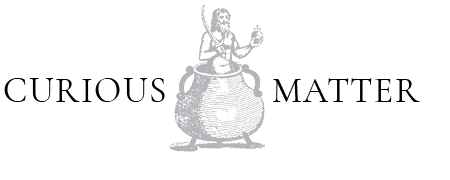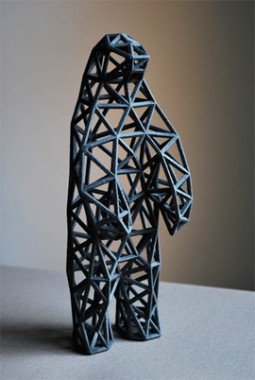Our Father and the Tiny Guardian
December 18, 2011 – January 29, 2012
Ryan Browning, Tiny Guardian, 2008.
OUR FINEST SENTIMENTS, most cherished traditions, and occasionally garish tendencies are revealed during these short, cold days of winter. The Menorah, Crèche, and a host of quasi-religious and pagan symbols such as the Christmas tree and Santa Claus seize our public spaces as no other time of year. According to our faith or philosophy we each endeavor to foster joy and illuminate the dark winter months with meaningful ornament. In keeping with the spirit of the season, Curious Matter has created a special installation to acknowledge, celebrate and join in the collective, festive impulse.
This year Curious Matter presents Tiny Guardian by Ryan Browning as the centerpiece of our holiday installation. Exhibited along with Browning’s sculpture are four lithographs from the 1800s by Martin Yauch and printed by Gies and Company.
Browning’s sculpture, Tiny Guardian, put us in mind of the popular religious icon, the Infant of Prague. Originally rendered in wax and just nineteen inches in height, the Infant statue has been reproduced, displayed and engulfed in embellishment in countless Catholic homes. This revered object is often adorned to the extreme. While intending to venerate, the relentless layering of satin, brocade and lace overwhelm the figure. To the uninitiated the extravagance might seem more suitable to a little girl’s favorite doll. In spite of this, the scale, symmetry and posture of Browning’s geodesic bear suggest a quality similar to the Infant of Prague. Both infant and bear stand sentinel, appearing calm and ready to intercede in times of need. Browning’s figure however is stripped of any superfluous decoration. What we see is the armature, the essential part upon which we imagine a complete entity.
The lithographs in our installation illustrate the Lord’s Prayer, the Ten Commandments and also scenes from the life of Christ. These are lavishly printed works that vividly communicate their religious content. The typography is ornate, intricate and the application of gold ink makes manifest the value and importance of the subject matter. The prints brought some of the grandeur of the church directly into the 19th Century homes for which they were designed. While as a rule Curious Matter exhibits contemporary art, perhaps it’s the sense of nostalgia that permeates this time of year that led us to include these prints as counterpoint to the modern, mathematical exactitude of Browning’s work.
The cabinet of curiosities serves as an inspiration in how we approach art at Curious Matter, each exhibition as an inquiry. Yet our point of view isn’t constrained by science and aesthetics. The religious, spiritual and sacred aspects that may inform a work are of matching interest. We don’t seek to negate or ignore the sanctity of objects simply because of the gallery setting. At the same time, identifying a link between Browning’s Tiny Guardian and the Infant of Prague doesn’t make Browning’s work a religious icon. However, theological perspectives inform our relationships to objects and works of art, whether our theology is an academic discipline or way of life.
The season has heightened our inclination towards awareness of the play between sacred and secular—our installation intends to honor both. We find these works compelling and beautiful and share them with our sincere wishes for a very fine holiday season.
3 Questions for Ryan Browning
It’s December, we can’t avoid the tinsel and bells, and having placed Ryan Browning’s Tiny Guardian at the center of our holiday installation we wanted his thoughts on holiday traditions, decorations and how spiritual aspects might exist in his work.
CURIOUS MATTER: Do you have a favorite holiday tradition from childhood? Have you continued the tradition?
RYAN BROWNING: We had pretty ordinary traditions growing up–Christmas tree, holiday music, presents, reading Luke chapter 2, etc. The thing that I miss though is visiting my grandparents– they had a lot of curious holiday decorations from Saudi Arabia (on my dad’s side) and Scandinavia (on my mom’s side) and I think some old kitschy holiday stuff as well. They would light fancy decorative candles. Their houses were typically dim and lamp lit–the environment was very memorable and made quite an impression on me. I miss the smells of their houses–like old wood. Only one of my grandfathers is still alive, and he has since moved to a new house, so that part of my life feels closed off. My wife and I have thought about having interesting candles around and lit, but our two kids are still small enough that it seems like any fire could be a potential hazard! Maybe someday soon we’ll try to continue that.
CM: Do you decorate your home or studio for the holiday season? If so, with what?
RB: We do decorate–we usually have a small tree with a number of ornaments we’ve made ourselves, plus some we’ve been given. We’re getting our kids to help us make things now–paper chains and the like. We try to keep it simple but magical.
CM: Does Tiny Guardian, or your art practice have any spiritual content for you?
RB: Yes–I see myself in a lot of the work I do, though I don’t often talk about it that way. Lately my works have become more ominously lifelike, though consisting of abstract shapes and forms. The Tiny Guardian piece and the larger sculpture that came out of it (Image Guardian) were to be a sort of totemic or avatar entity, kind of like a sculpted spirit animal. I was interested in the process of designing this piece virtually, from that design a physical version was produced. At the time, I was thinking of this as a kind of quasi-spiritual conversion to matter. I still think of my work as an engagement with the image space or sculptural form as a location for virtual activity or creation–and there is something spiritual about that, I would say (in a meditative, existential kind of way).
Ryan Browning was born in Houston, Texas and currently living in Maryland. He studied Art History and Curatorial Studies at Brigham Young University and received his MFA from MICA’s Mount Royal School of Art. His solo exhibition Lairs will open in 2012 at Esther Prangley Rice Gallery in Westminster, MD.


